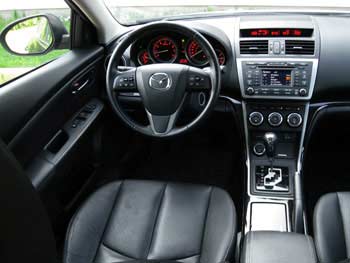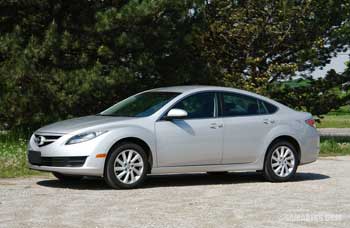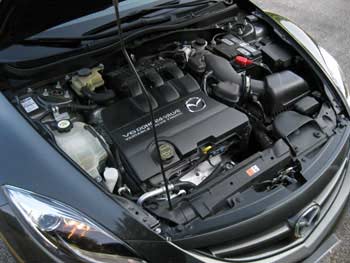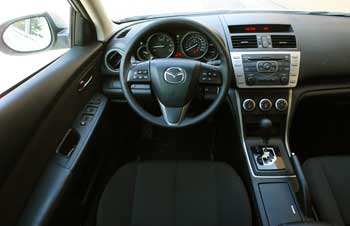Mazda 6 2009-2013: pros and cons, common problems
Updated: November 11, 2022
Very few family sedans can be described as "fun to drive" and the Mazda 6 is one of them. The 6's optional 3.7L V6 engine tops most family sedans in horsepower and torque.
The 6 handles well and even got the perfect 5-star rollover resistance rating from the NHTSA.The sporty styling makes it stand out from the crowd. Mazda 6 is roomy and the trunk is huge (16.6 cu. ft). The 60/40 split seatbacks fold down flat with the trunk floor. The 6 is fairly reliable and doesn't cost a lot to maintain. What are the downsides? How is the gas mileage? What are the common problems? Let's take a closer look, starting with the pros and cons.
Pros:
- Spacious interior, large trunk.
- With a 4-cylinder engine, the 2009-2013 Mazda 6 can last for 200,000 miles if it's not too rusted.
- Even if the 4-cylinder engine or transmission will need to be replaced, a used engine or transmission are not too expensive compared to some other cars.
- Sporty handling, especially with V6 power.
- Easy to maintain. The 4-cylinder engine is simple and easy to work on.
- Comes with a manual transmission.
- The driver's seat is not super comfortable.
- The V6 is bad on gas; the 4-cylinder Mazda 6 is better, but it's not as fuel-efficient as some other similar cars (e.g., Nissan Altima).
- If the water pump fails in a V6, the repair will be expensive.
- Front brakes wear fast.
We recommend looking for a 4-cylinder model, as if the water pump fails in the V6 at higher mileage, the repair will be very expensive.
Common problems in 4-cylinder models are mostly minor, such as a failing thermostat, headlight bulbs going bad often, warped front rotors causing steering wheel to shake when braking and electrical issues with the Push Button Start. Models with an old-school ignition key are less troublesome. Read more about the problems:
The thermostat can fail in a 4-cylinder engine causing the code P0128. Replacing a thermostat will cost 1.5-1.9 hours of labor plus the part, which is not too expensive.
Mazda issued the recall 2818I (NHTSA Campaign Number: 18V631000) for the front cross-member (subframe) corrosion in certain states. The subframe must be inspected and repaired or replaced. Check for recalls at the NHTSA website
One of the bolts at the rear exhaust flange can brake and cause an exhaust leak and louder exhaust noise. Replacing one bolt is and the gasket is an easy repair and any local shop can handle it for a reasonable price.
A faulty purge valve can cause the Check Engine light to come on. The scan may reveal the code P0446. A bad purge valve must be replaced, which is an easy repair. The part can be purchased within $100.
Several owners from the southern states mentioned that the dashboard material becomes very soft and 'melts' on hot sunny days. Some owners suggest using a windshield screen and open all the windows just 1/4 of an inch so the air can circulate to prevent the problem.
In models with a Push button start, the locking system with smart key fobs can be troublesome at higher mileage. The switch in the driver's door handle and issues with the fobs can cause problems at higher mileage. If you are buying a used Mazda 6, the model with regular key ignition is preferable as it will be less glitchy.
Advertisement
A faulty door lock actuator at one of the doors can cause an alarm to go off randomly. Often this happens after rain, as water gets in the door lock actuators through the gaps in the weatherstrips. Your dealer can check with the scan tool which door has triggered the alarm and if confirmed replace the faulty door lock actuator.
The low beam headlight bulbs go bad often. Due to the design, the inner fender (fender liner) of the front wheel must be partially removed to change the bulb. Watch these videos on how to change the headlight bulb.
2.5L 4-cylinder vs 3.7L V6 engines: The 170-hp 2.5-liter inline-4 DOHC is available with a 6-speed manual or 5-speed automatic transmission. Overall, it's a proven reliable workhorse; it's used in many Mazda and Ford vehicles and is a preferred choice in our view.
The 272-hp 3.7-liter Ford-sourced V6 comes only with the 6-speed automatic. This is a strong solid engine; the only problem is the location of the water pump. If the water pump fails, it will be very expensive to replace, as it's driven by a timing chain.
Does the 2009-2013 Mazda 6 have a timing chain or belt? Both the 4-cylinder and V6 engines have a maintenance-free timing chain; there is no timing belt to worry about.
| EPA Fuel Economy: | mpg city/hwy |
L/100 km city/hwy |
| 2011-2012 Mazda 6 4-cyl, auto | 22/31 | 10.7/7.6 |
| 2009-2011 Mazda 6 4-cyl, auto | 22/30 | 10.7/7.8 |
| 2013 Mazda 6 4-cyl, auto | 22/30 | 10.7/7.8 |
| 2011-2013 Mazda 6 4-cyl, manual | 21/30 | 11.2/7.8 |
| 2009-2010 Mazda 6 4-cyl, manual | 20/29 | 11.8/8.1 |
| 2011-2013 Mazda 6 V6, auto | 18/27 | 13.1/8.7 |
| 2009-2010 Mazda 6 V6, auto | 17/25 | 13.8/9.4 |
Similar cars: Competitors include Toyota Camry, Nissan Altima, Honda Accord, Chevrolet Malibu, Ford Fusion and Hyundai Sonata. The Camry is more reliable and is known for its very comfortable and quiet ride. It also offers better highway gas mileage. Nissan Altima handles well too and gets better city gas mileage, but it's a bit smaller. The Honda Accord is an overall excellent car, but it's priced a bit higher.
Related reviews:
Mazda 6 2003-2008
Mazda 3 2010-2013
Honda Accord 2013-2017
Toyota Camry 2012-2017
Toyota Camry 2007-2011
Nissan Altima 2007-2012
Honda Accord 2008-2012
Mazda 6 2014-2019
Acura TL 2004-2008
What to look for when buying a used Mazda 6: Check if all the recalls have been completed. Test all inside electricals: the A/C, locks, windows, sunroof, etc. Watch out for rust at the bottom of the doors (on the inner side) and underneath the car. If you can arrange for the pre-purchase inspection in the shop, ask them to check the vehicle underneath for rust (including the subframe), oil leaks and other problems. Avoid cars that are too rusted. Test the controls on the steering, audio system, power locks and the air conditioner. See if the driver's seat is comfortable for you. When checking under the hood, see if the battery terminals are not corroded. Check the oil level and condition; low oil level may indicate that the engine consumes oil. Avoid the car if there is blue smoke from the exhaust. During the test drive, see if the car holds the road well and doesn't pull to one side or another. See if the transmission shifts smoothly. Read more: Signs of automatic transmission problems when test driving a used car. Read also:
How to inspect a used car - illustrated guide.
What mileage is OK for a used car?
Maintenance: For the US and Canada, Mazda recommends using 0W-20 synthetic oil in the 2011 and newer 4-cylinder models. Older models take 5W-20 oil. Change the transmission fluid every 60,000 miles or so; visit your Mazda dealer to get it done with the correct fluid.
Tires will last longer if rotated regularly; radial and directional tires are rotated front to rear on the same side. Radial tires have the letter “R” in the tire size; for example, P215/55 R17 are radial tires.
When you have your oil change done, ask to check the battery terminals. In some cars, the electrolyte leaking out from the battery can damage the battery cable, which is expensive to replace.
A cabin air filter needs to be replaced every 2 years or 25,000 miles (40,000 km). Have your brakes checked regularly, as the front brakes are known to wear prematurely.
If you live in the Salt Belt, rustproofing will help preserve some underneath parts, such as brake and power steering lines, rear crossmember and the subframe and the lower portion of the doors from rusting.
Handling and ride: Handling is where the Mazda 6 excels. It holds the road well with minimal body roll in corners. The steering is precise and well-weighted. The ride is firm but compliant. The 2.5L engine is overall a decent performer and pulls lively off the line. The 3.7L V6 is very strong. The 0-to-60 time for the V6 is just over 6.0 seconds. The V6 Mazda 6 feels very solid and exceptionally stable on the road. On the downside, some road and tire noise are noticeable.
Safety: Anti-lock brakes (ABS) and stability control (DSC) are standard. Late models offer an optional Blind Spot Monitoring system that warns the driver about vehicles approaching from the rear to the left and right of the car. The 2009 and 2010 Mazda 6 have earned a perfect five-star rating in the NHTSA crash tests, including five stars for rollover resistance. In the new, more rigorous crash tests introduced by the NHTSA from 2011, the 2012 and 2013 Mazda 6 scored 4 stars overall.



